
buster
Buster is an open-source platform for deploying AI data analysts
Stars: 449
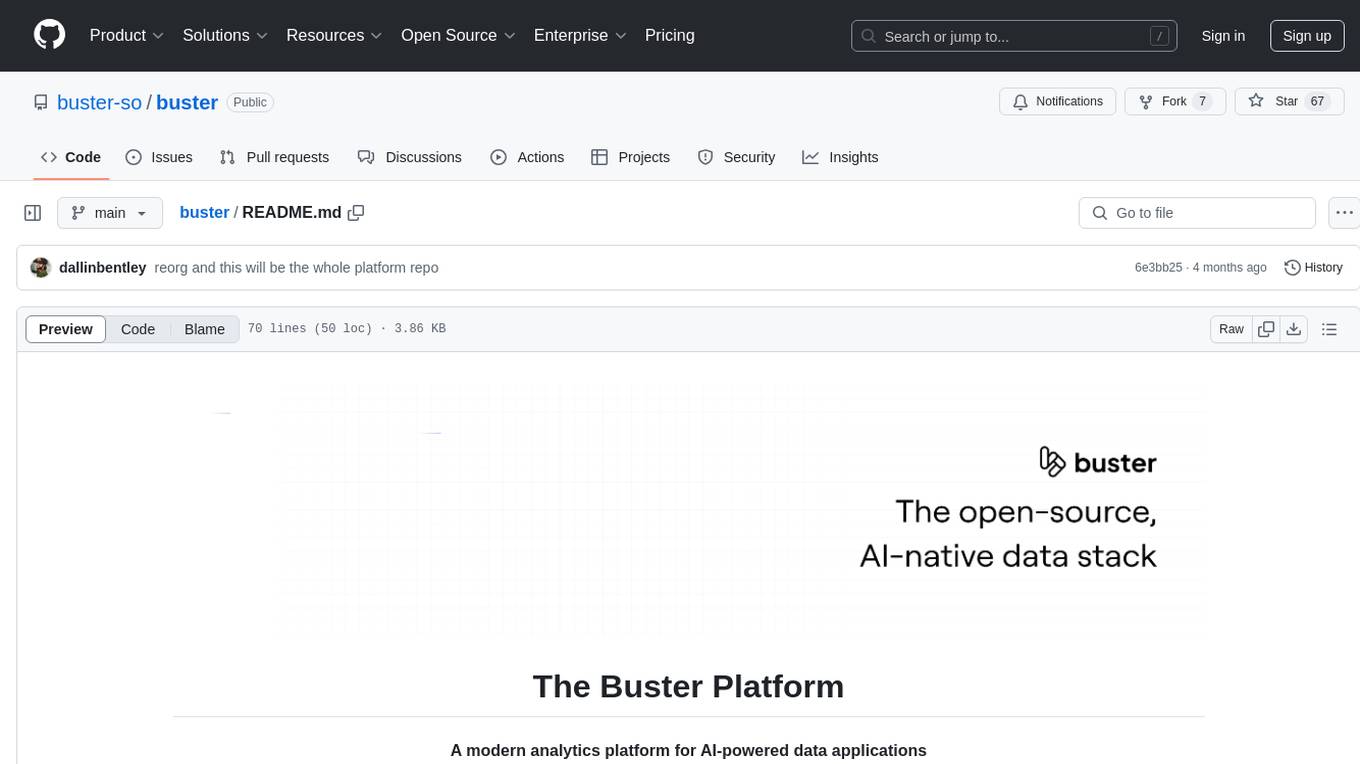
Buster is a modern analytics platform designed with AI in mind, focusing on self-serve experiences powered by Large Language Models. It addresses pain points in existing tools by advocating for AI-centric app development, cost-effective data warehousing, improved CI/CD processes, and empowering data teams to create powerful, user-friendly data experiences. The platform aims to revolutionize AI analytics by enabling data teams to build deep integrations and own their entire analytics stack.
README:
A modern data analytics platform that enables teams to interact with their data through AI-powered conversations, beautiful dashboards, and automated insights.
- Node.js 20+
- pnpm 9+
- PostgreSQL (via Supabase local or cloud)
- Clone the repository
git clone https://github.com/buster-so/buster.git
cd buster- Install dependencies
pnpm install- Set up environment variables
cp .env.example .env
# Edit .env with your configuration- Start development servers
turbo devThe application will be available at:
- Web app: http://localhost:3000
- API server: http://localhost:8080
Buster follows a modular monorepo architecture where:
- Packages are standalone building blocks containing reusable logic and types
- Apps assemble packages to create user-facing applications
| App | Description | Stack |
|---|---|---|
@buster-app/web |
Main web application | TanStack Start, React |
@buster-app/server |
API server | Node.js, Hono |
@buster-app/trigger |
Background job processor | Trigger.dev v3 |
@buster-app/cli |
Command-line interface | TypeScript, Bun |
@buster-app/electric-server |
Real-time sync server | Electric SQL |
@buster-app/api |
Legacy API (being migrated) | Rust (deprecated) |
| Package | Purpose |
|---|---|
@buster/database |
Database schema, migrations, and ALL query logic (Drizzle ORM) |
@buster/server-shared |
API contracts, request/response types |
@buster/data-source |
Customer database connectors (PostgreSQL, MySQL, BigQuery, Snowflake) |
@buster/ai |
AI agents and workflows (AI SDK v5) |
@buster/access-controls |
Permission and security logic |
All development commands use Turbo for optimal caching and parallelization:
# Building
turbo build # Build entire monorepo
turbo build --filter=@buster/ai # Build specific package
# Linting
turbo lint # Lint entire monorepo
turbo lint --filter=@buster-app/web # Lint specific app
# Testing
turbo test:unit # Run all unit tests
turbo test:unit --filter=@buster/database # Test specific package
# Development
turbo dev # Start all dev servers
turbo dev --filter=@buster-app/web # Start specific app- Write tests first - Follow test-driven development
-
Check types - Run
turbo buildto ensure type safety -
Lint code - Run
turbo lintto maintain code quality -
Run tests - Run
turbo test:unitbefore committing
Tests are colocated with source files:
-
file.test.ts- Unit tests -
file.int.test.ts- Integration tests
turbo test:unit # Fast, isolated unit tests
turbo test:integration # Tests with external dependenciesFor local development with Supabase:
# Start Supabase locally
npx supabase start
# Run migrations
turbo db:migrate
# Access database
psql "postgresql://postgres:[email protected]:54322/postgres"We follow functional programming principles:
- Pure functions over classes
- Immutable data structures
- Type-safe with Zod schemas
- Modular, composable code
- Create a feature branch
- Write tests for new functionality
- Ensure
turbo build lint test:unitpasses - Submit PR with clear description
- Address review feedback
- Each package/app has its own README.md
- CLAUDE.md files provide AI assistant guidance
- Keep documentation close to code
buster/
├── apps/ # User-facing applications
│ ├── web/ # Main web application
│ ├── server/ # API server
│ ├── trigger/ # Background jobs
│ └── cli/ # Command-line tools
├── packages/ # Reusable modules
│ ├── database/ # Database layer
│ ├── server-shared/ # API contracts
│ ├── data-source/ # Data connectors
│ └── ai/ # AI capabilities
├── turbo.json # Turbo configuration
├── package.json # Root package.json
└── .env.example # Environment template
- Frontend: React, TanStack Start, TailwindCSS
- Backend: Node.js, Hono, TypeScript
- Database: PostgreSQL (Supabase), Drizzle ORM
- AI: OpenAI, Anthropic, AI SDK v5
- Background Jobs: Trigger.dev v3
- Testing: Vitest
- Build: Turborepo, pnpm
Note: The Rust API (apps/api) is legacy code being migrated to TypeScript. All new development should use the TypeScript stack in apps/server.
[License information]
[Support channels and documentation links]
For Tasks:
Click tags to check more tools for each tasksFor Jobs:
Alternative AI tools for buster
Similar Open Source Tools

buster
Buster is a modern analytics platform designed with AI in mind, focusing on self-serve experiences powered by Large Language Models. It addresses pain points in existing tools by advocating for AI-centric app development, cost-effective data warehousing, improved CI/CD processes, and empowering data teams to create powerful, user-friendly data experiences. The platform aims to revolutionize AI analytics by enabling data teams to build deep integrations and own their entire analytics stack.
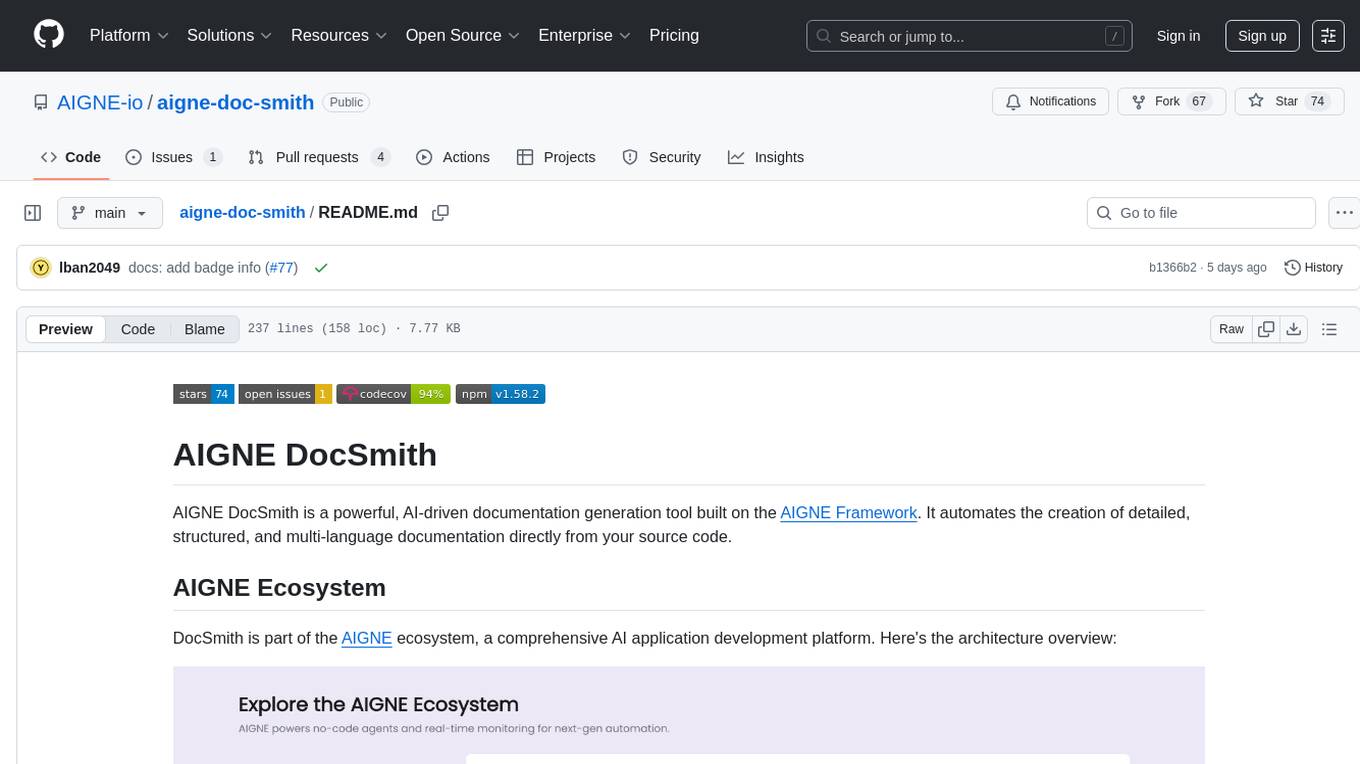
aigne-doc-smith
AIGNE DocSmith is a powerful AI-driven documentation generation tool that automates the creation of detailed, structured, and multi-language documentation directly from source code. It intelligently analyzes codebase to generate a comprehensive document structure, populates content with high-quality AI-powered generation, supports seamless translation into 12+ languages, integrates with AIGNE Hub for large language models, offers Discuss Kit publishing, automatically updates documentation with source code changes, and allows for individual document optimization.
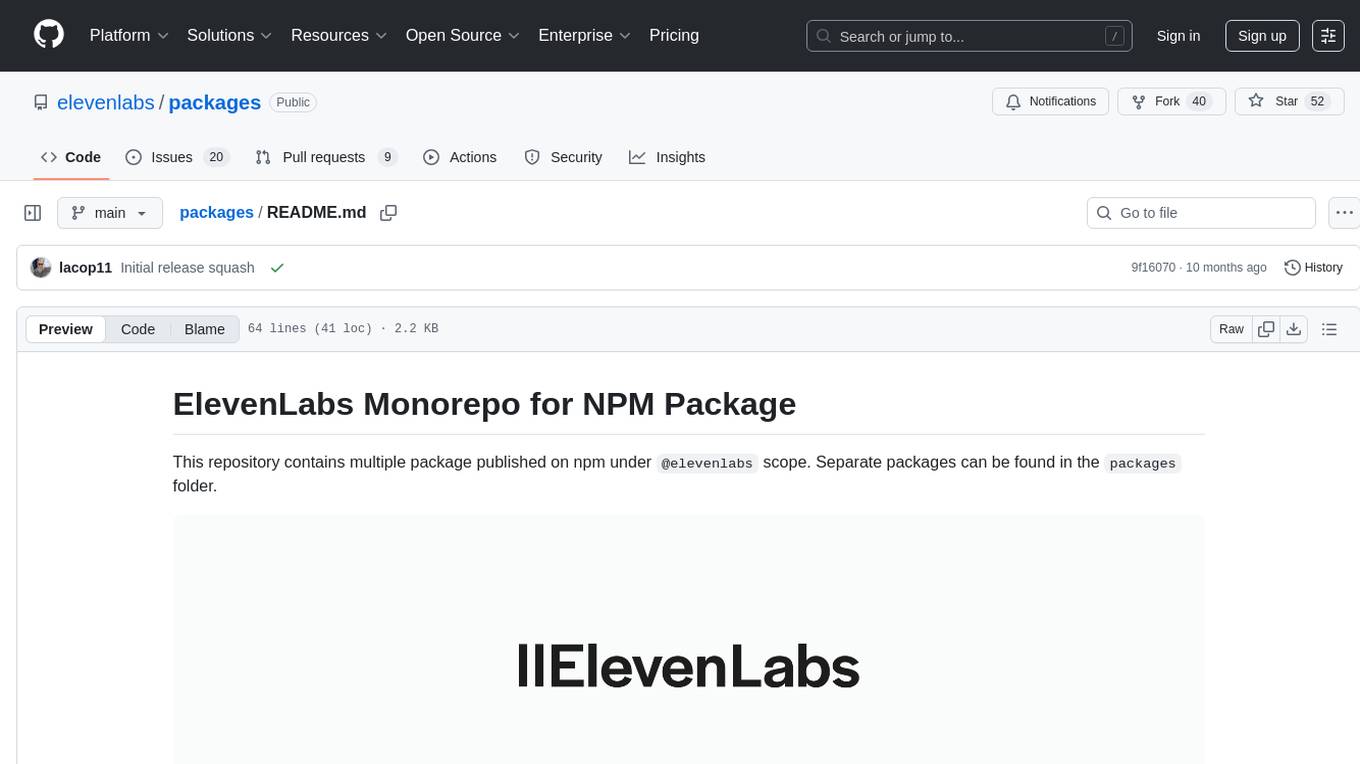
packages
This repository is a monorepo for NPM packages published under the `@elevenlabs` scope. It contains multiple packages in the `packages` folder. The setup allows for easy development, linking packages, creating new packages, and publishing them with GitHub actions.
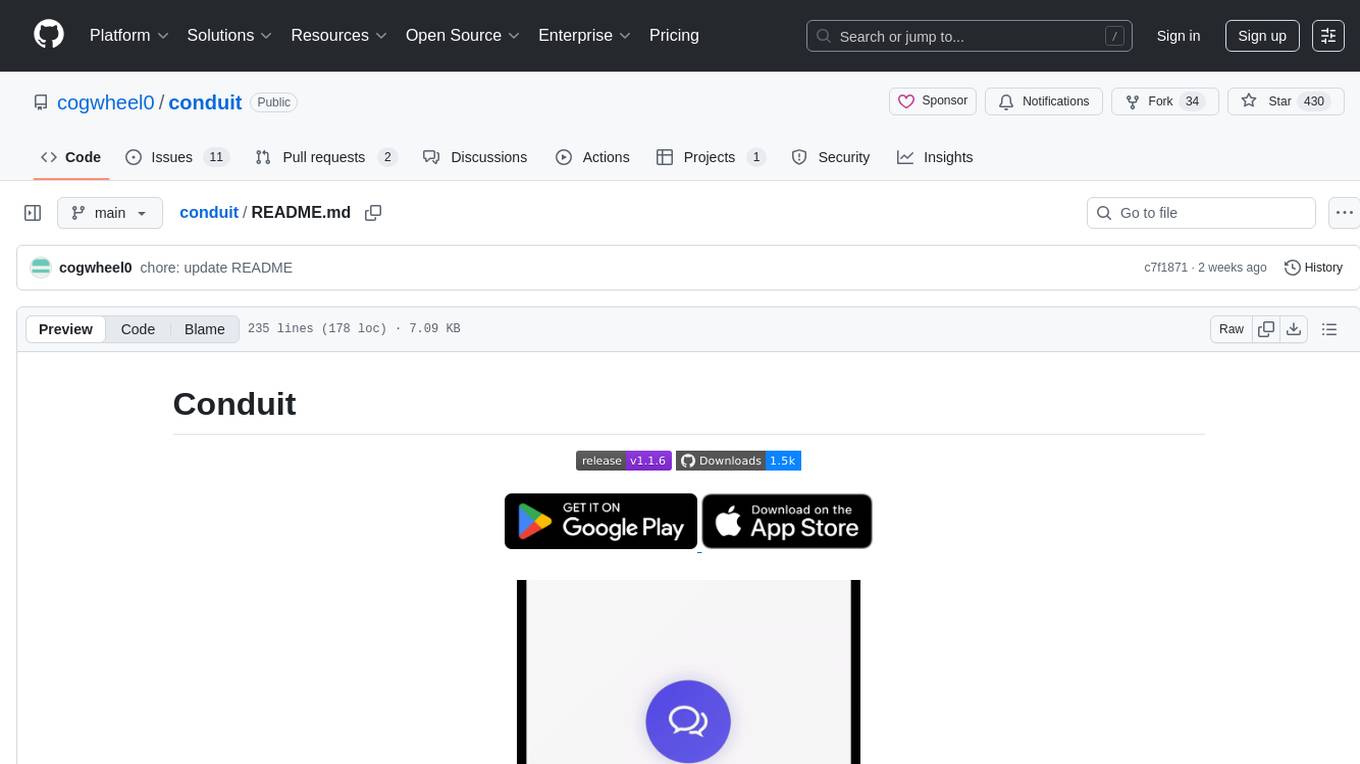
conduit
Conduit is an open-source, cross-platform mobile application for Open-WebUI, providing a native mobile experience for interacting with your self-hosted AI infrastructure. It supports real-time chat, model selection, conversation management, markdown rendering, theme support, voice input, file uploads, multi-modal support, secure storage, folder management, and tools invocation. Conduit offers multiple authentication flows and follows a clean architecture pattern with Riverpod for state management, Dio for HTTP networking, WebSocket for real-time streaming, and Flutter Secure Storage for credential management.
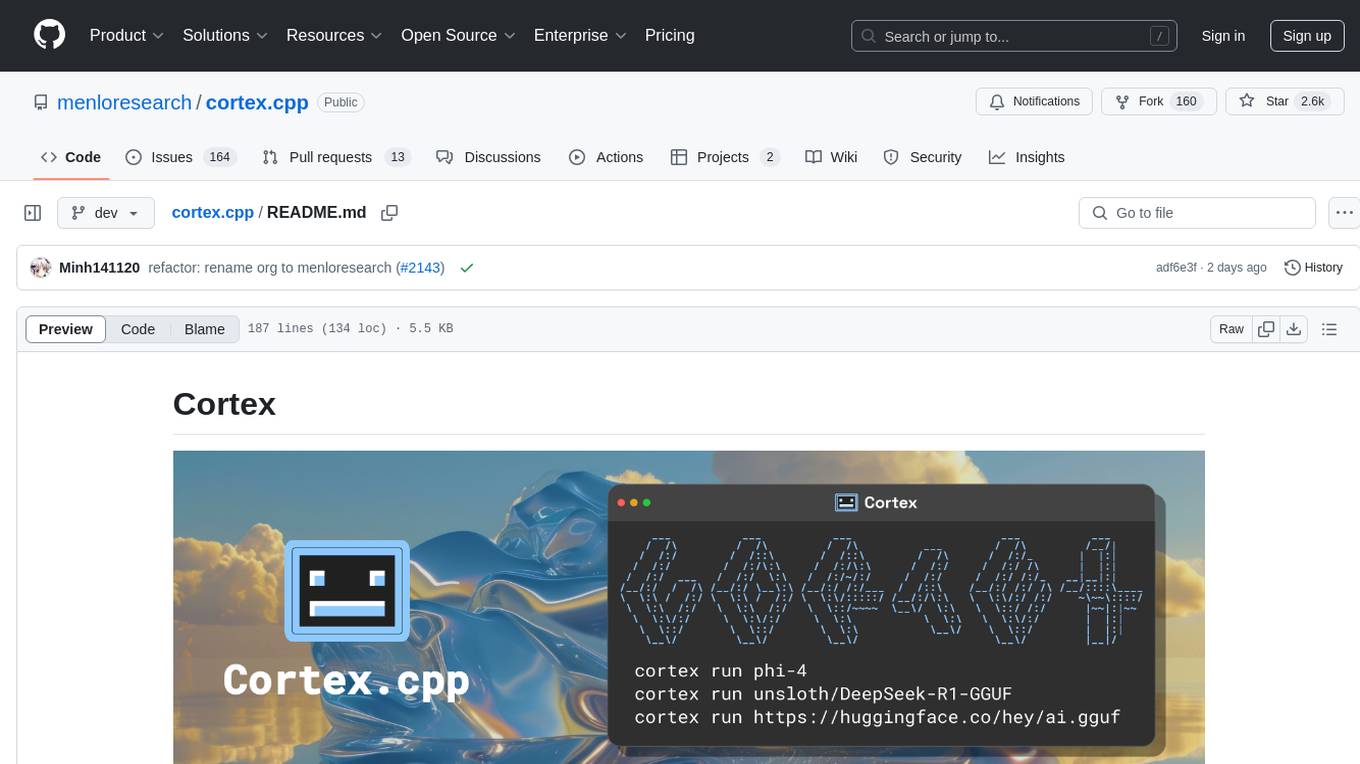
cortex.cpp
Cortex.cpp is an open-source platform designed as the brain for robots, offering functionalities such as vision, speech, language, tabular data processing, and action. It provides an AI platform for running AI models with multi-engine support, hardware optimization with automatic GPU detection, and an OpenAI-compatible API. Users can download models from the Hugging Face model hub, run models, manage resources, and access advanced features like multiple quantizations and engine management. The tool is under active development, promising rapid improvements for users.

wa_llm
WhatsApp Group Summary Bot is an AI-powered tool that joins WhatsApp groups, tracks conversations, and generates intelligent summaries. It features automated group chat responses, LLM-based conversation summaries, knowledge base integration, persistent message history with PostgreSQL, support for multiple message types, group management, and a REST API with Swagger docs. Prerequisites include Docker, Python 3.12+, PostgreSQL with pgvector extension, Voyage AI API key, and a WhatsApp account for the bot. The tool can be quickly set up by cloning the repository, configuring environment variables, starting services, and connecting devices. It offers API usage for loading new knowledge base topics and generating & dispatching summaries to managed groups. The project architecture includes FastAPI backend, WhatsApp Web API client, PostgreSQL database with vector storage, and AI-powered message processing.
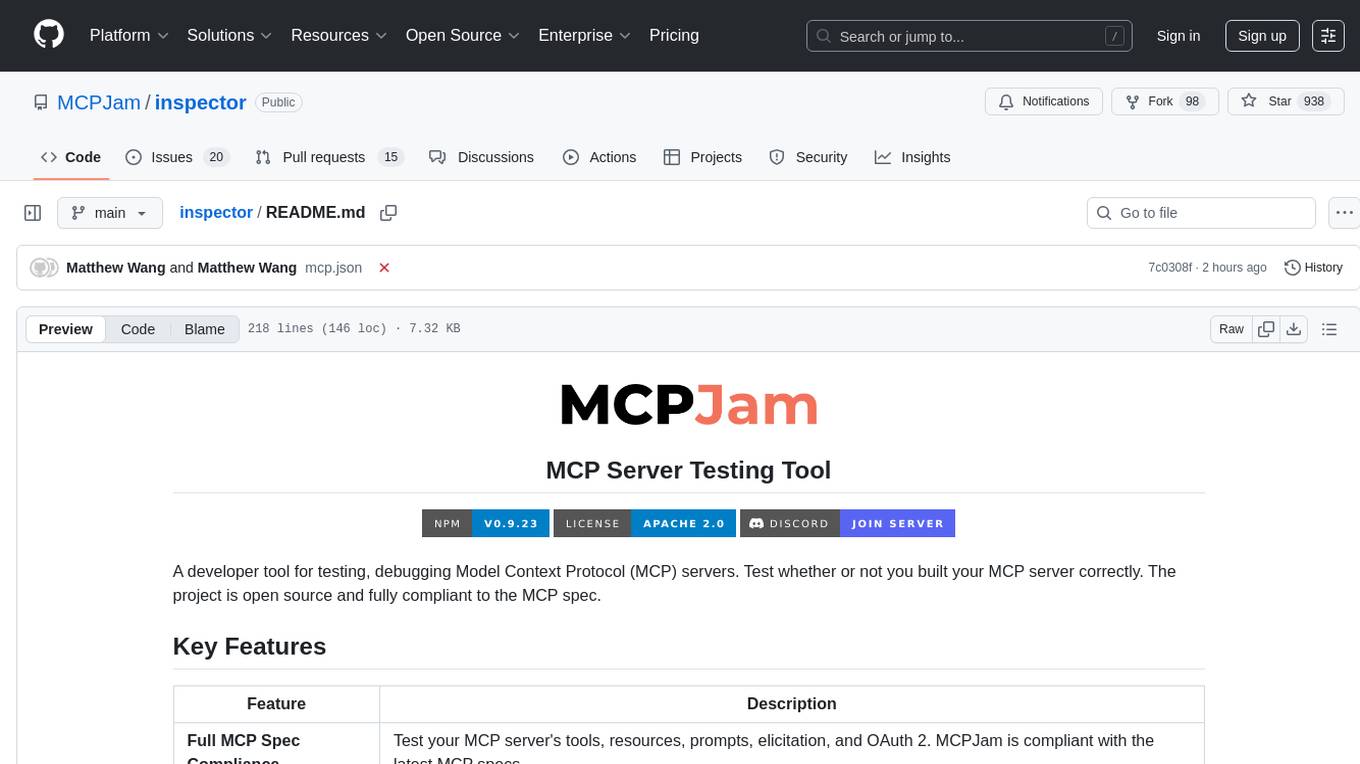
inspector
A developer tool for testing and debugging Model Context Protocol (MCP) servers. It allows users to test the compliance of their MCP servers with the latest MCP specs, supports various transports like STDIO, SSE, and Streamable HTTP, features an LLM Playground for testing server behavior against different models, provides comprehensive logging and error reporting for MCP server development, and offers a modern developer experience with multiple server connections and saved configurations. The tool is built using Next.js and integrates MCP capabilities, AI SDKs from OpenAI, Anthropic, and Ollama, and various technologies like Node.js, TypeScript, and Next.js.
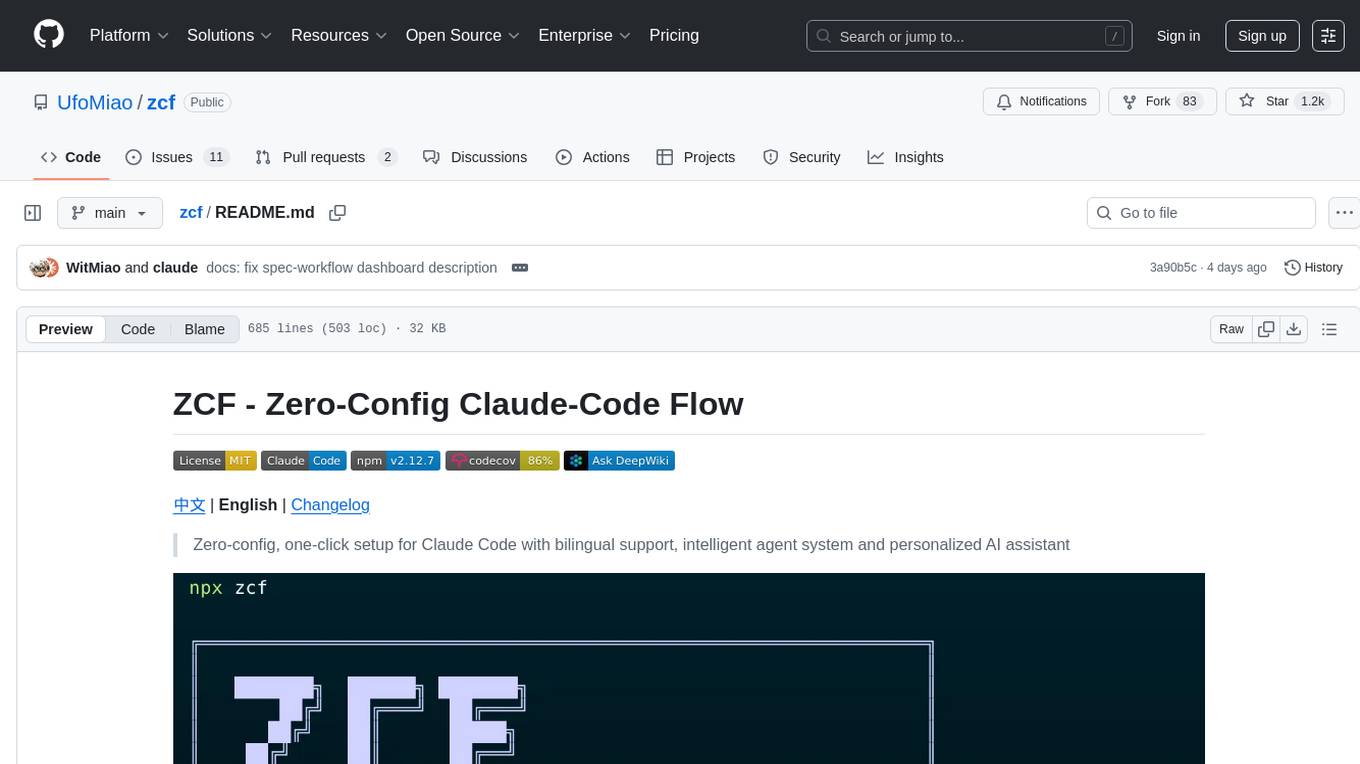
zcf
ZCF (Zero-Config Claude-Code Flow) is a tool that provides zero-configuration, one-click setup for Claude Code with bilingual support, intelligent agent system, and personalized AI assistant. It offers an interactive menu for easy operations and direct commands for quick execution. The tool supports bilingual operation with automatic language switching and customizable AI output styles. ZCF also includes features like BMad Workflow for enterprise-grade workflow system, Spec Workflow for structured feature development, CCR (Claude Code Router) support for proxy routing, and CCometixLine for real-time usage tracking. It provides smart installation, complete configuration management, and core features like professional agents, command system, and smart configuration. ZCF is cross-platform compatible, supports Windows and Termux environments, and includes security features like dangerous operation confirmation mechanism.
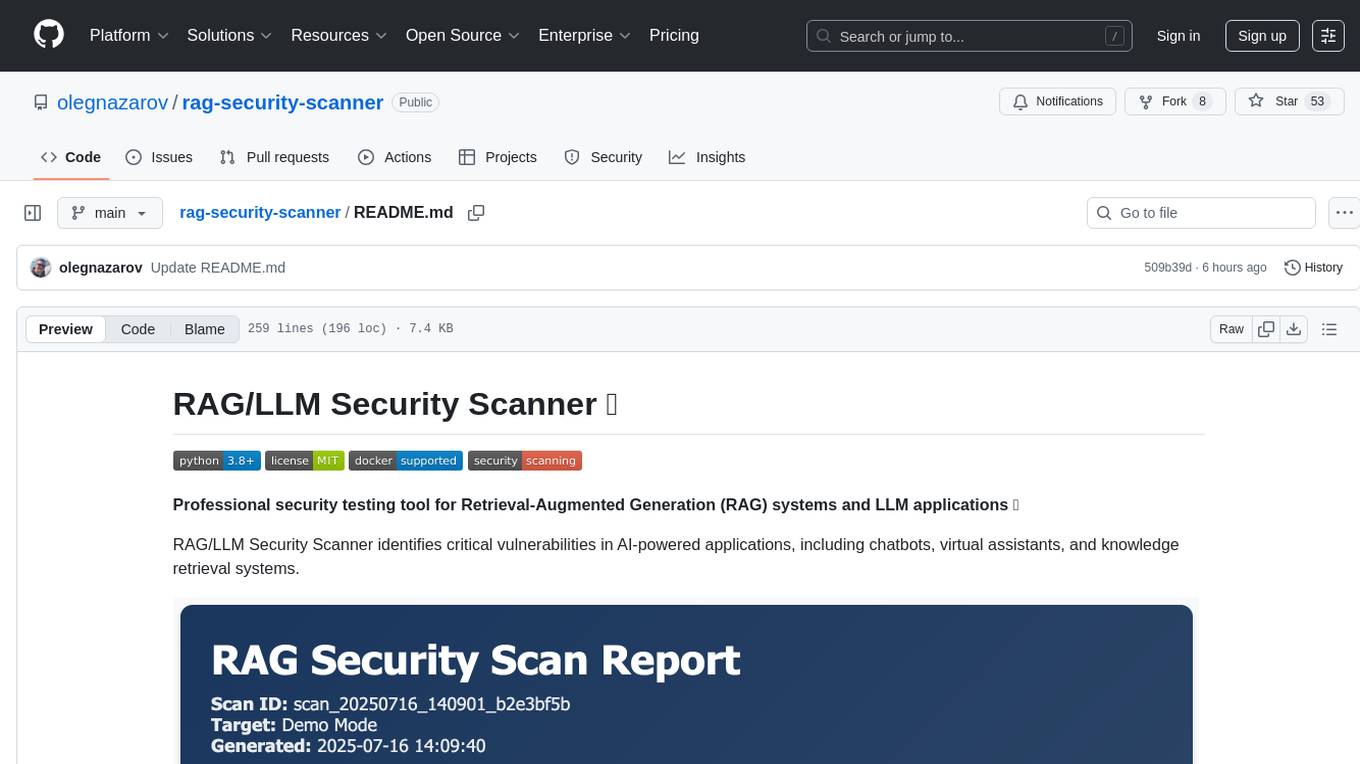
rag-security-scanner
RAG/LLM Security Scanner is a professional security testing tool designed for Retrieval-Augmented Generation (RAG) systems and LLM applications. It identifies critical vulnerabilities in AI-powered applications such as chatbots, virtual assistants, and knowledge retrieval systems. The tool offers features like prompt injection detection, data leakage assessment, function abuse testing, context manipulation identification, professional reporting with JSON/HTML formats, and easy integration with OpenAI, HuggingFace, and custom RAG systems.
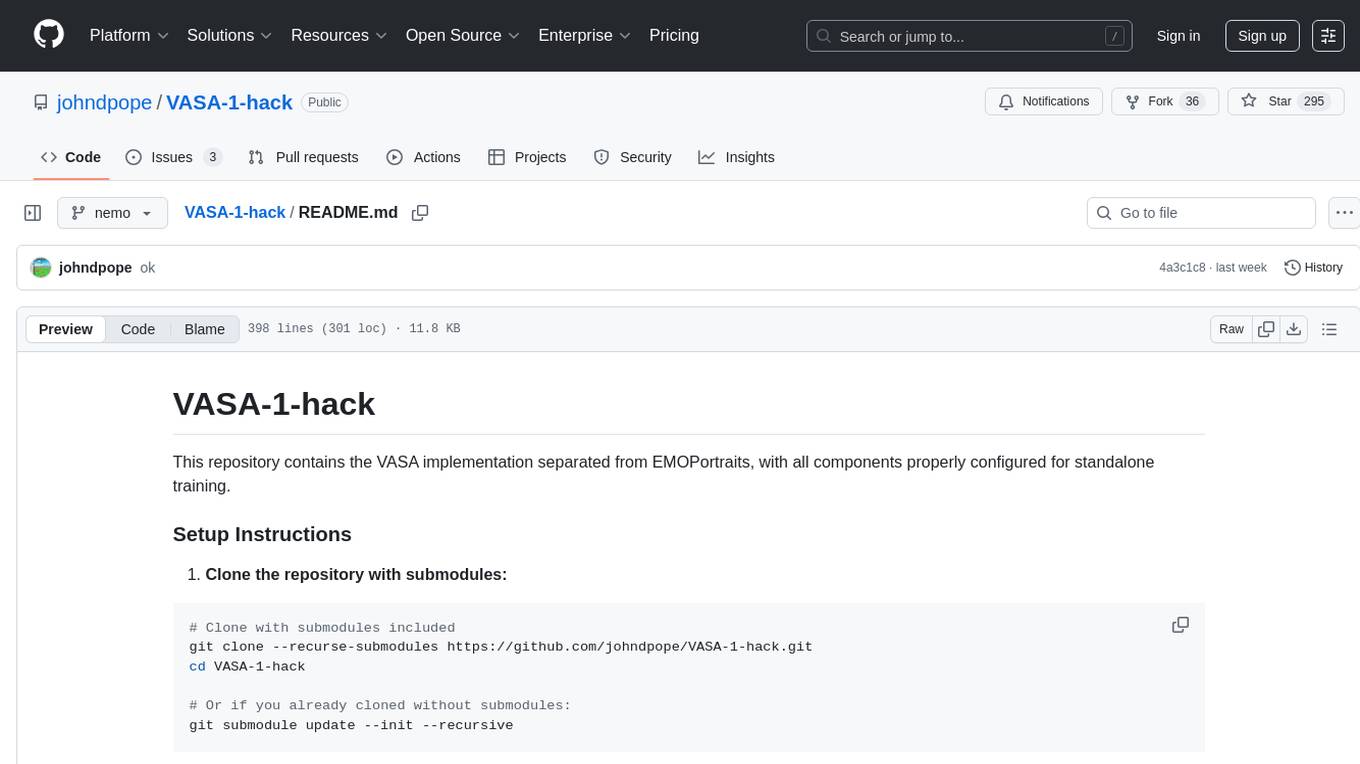
VASA-1-hack
VASA-1-hack is a repository containing the VASA implementation separated from EMOPortraits, with all components properly configured for standalone training. It provides detailed setup instructions, prerequisites, project structure, configuration details, running training modes, troubleshooting tips, monitoring training progress, development information, and acknowledgments. The repository aims to facilitate training volumetric avatar models with configurable parameters and logging levels for efficient debugging and testing.
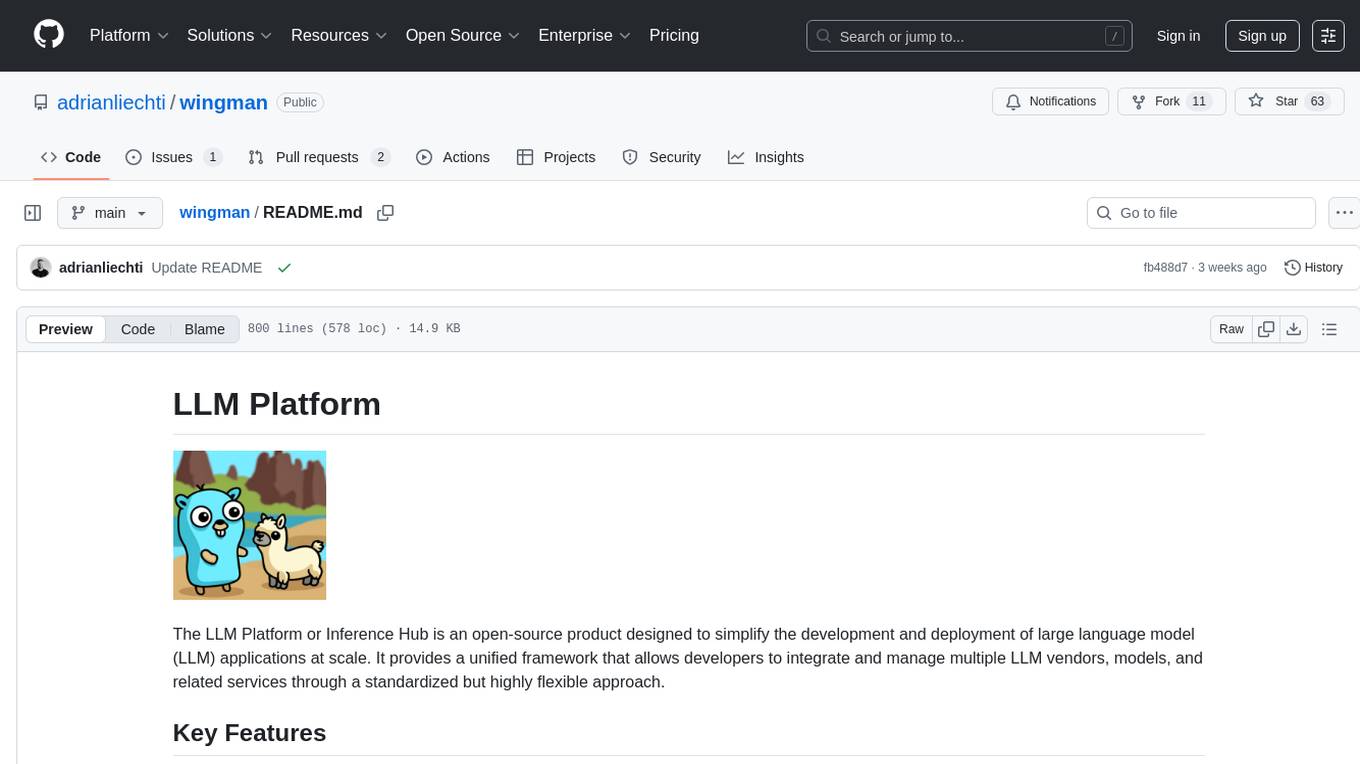
wingman
The LLM Platform, also known as Inference Hub, is an open-source tool designed to simplify the development and deployment of large language model applications at scale. It provides a unified framework for integrating and managing multiple LLM vendors, models, and related services through a flexible approach. The platform supports various LLM providers, document processing, RAG, advanced AI workflows, infrastructure operations, and flexible configuration using YAML files. Its modular and extensible architecture allows developers to plug in different providers and services as needed. Key components include completers, embedders, renderers, synthesizers, transcribers, document processors, segmenters, retrievers, summarizers, translators, AI workflows, tools, and infrastructure components. Use cases range from enterprise AI applications to scalable LLM deployment and custom AI pipelines. Integrations with LLM providers like OpenAI, Azure OpenAI, Anthropic, Google Gemini, AWS Bedrock, Groq, Mistral AI, xAI, Hugging Face, and more are supported.
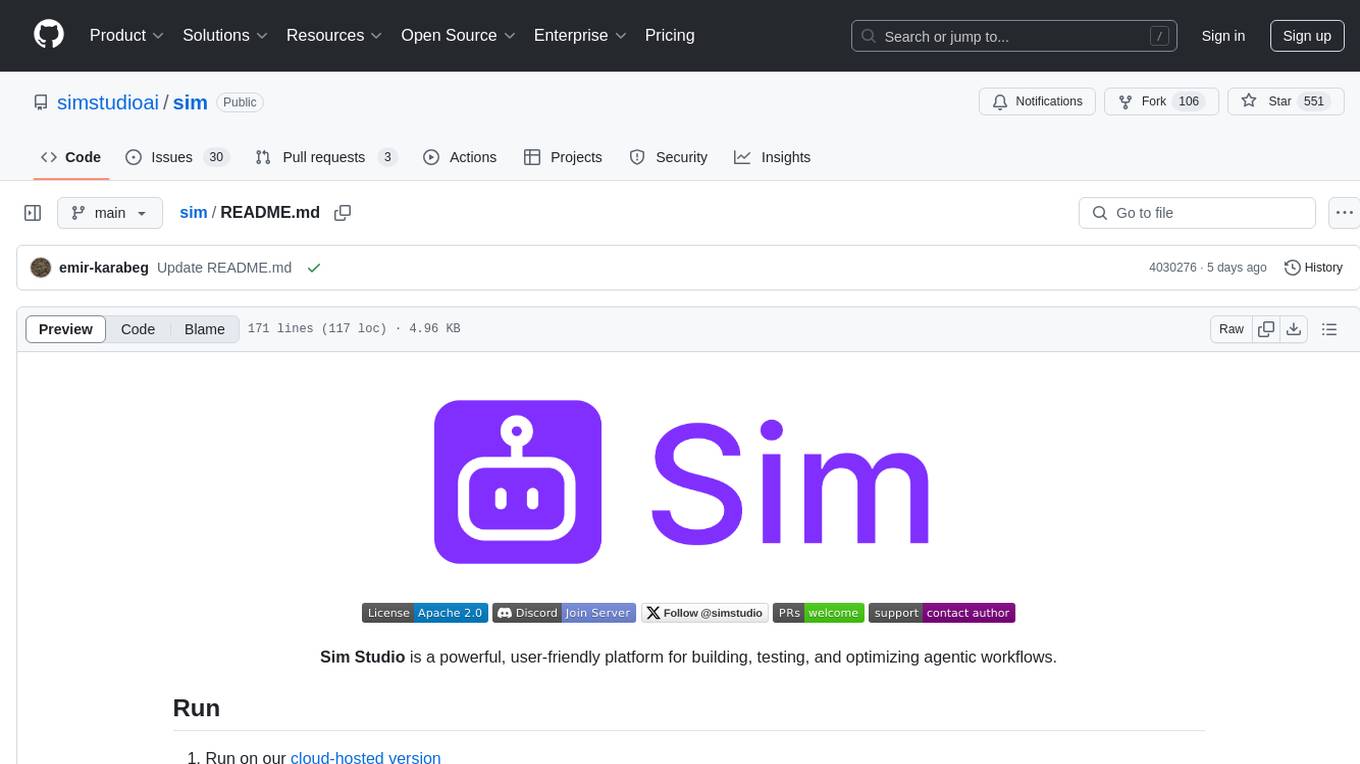
sim
Sim is a platform that allows users to build and deploy AI agent workflows quickly and easily. It provides cloud-hosted and self-hosted options, along with support for local AI models. Users can set up the application using Docker Compose, Dev Containers, or manual setup with PostgreSQL and pgvector extension. The platform utilizes technologies like Next.js, Bun, PostgreSQL with Drizzle ORM, Better Auth for authentication, Shadcn and Tailwind CSS for UI, Zustand for state management, ReactFlow for flow editor, Fumadocs for documentation, Turborepo for monorepo management, Socket.io for real-time communication, and Trigger.dev for background jobs.
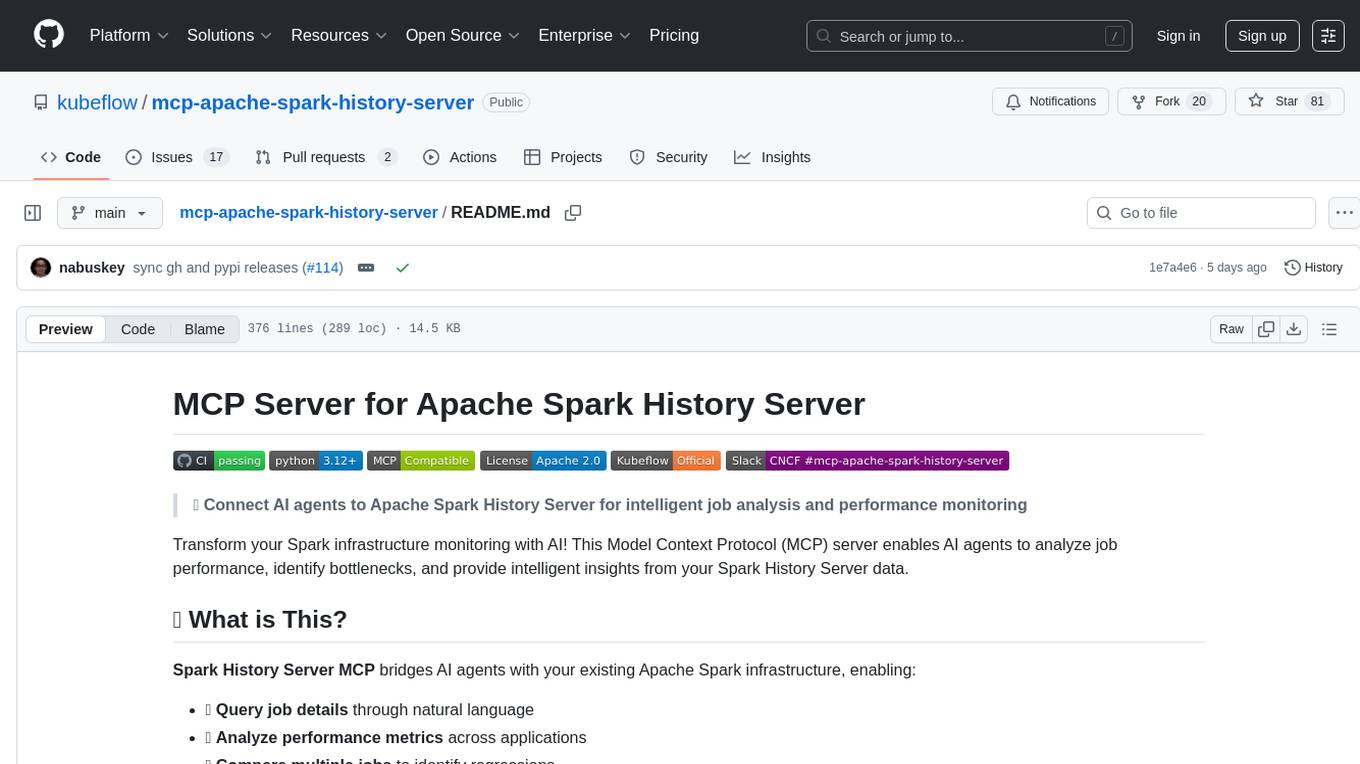
mcp-apache-spark-history-server
The MCP Server for Apache Spark History Server is a tool that connects AI agents to Apache Spark History Server for intelligent job analysis and performance monitoring. It enables AI agents to analyze job performance, identify bottlenecks, and provide insights from Spark History Server data. The server bridges AI agents with existing Apache Spark infrastructure, allowing users to query job details, analyze performance metrics, compare multiple jobs, investigate failures, and generate insights from historical execution data.
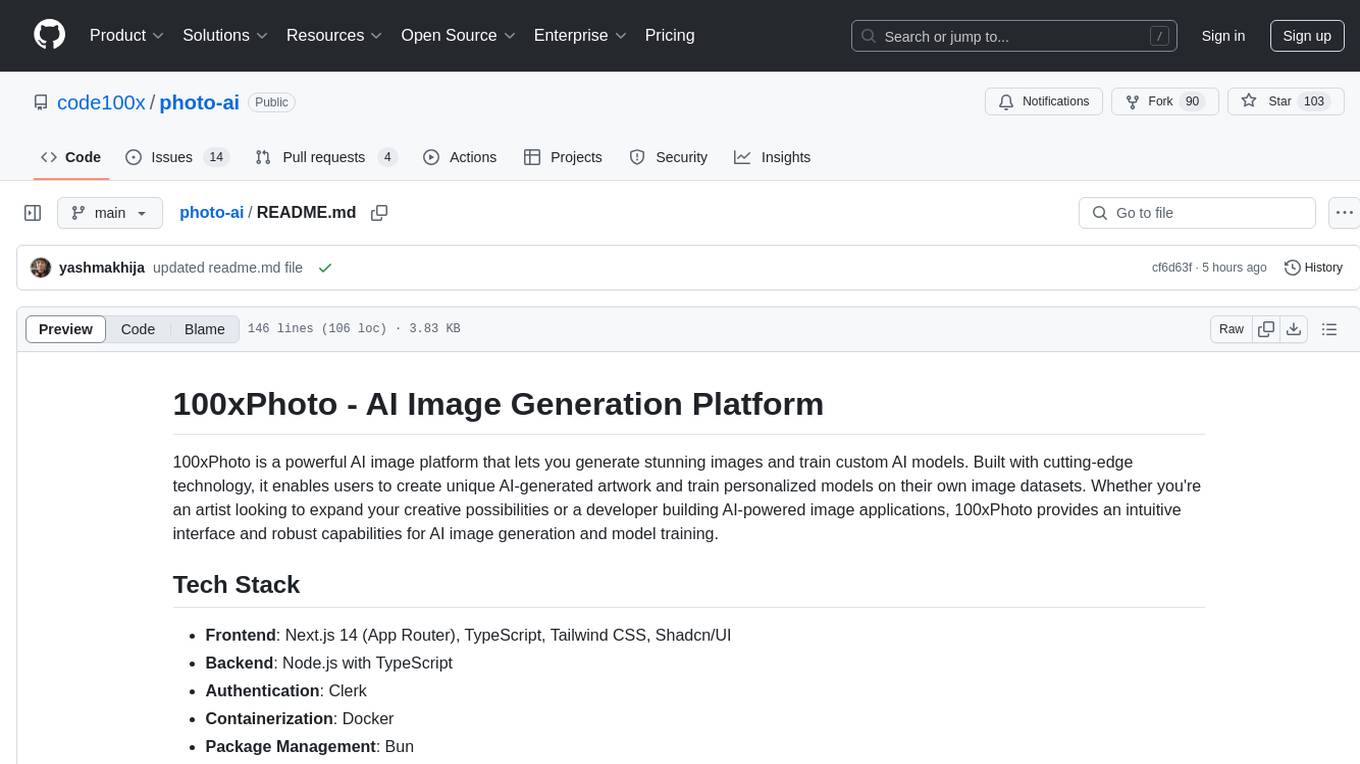
photo-ai
100xPhoto is a powerful AI image platform that enables users to generate stunning images and train custom AI models. It provides an intuitive interface for creating unique AI-generated artwork and training personalized models on image datasets. The platform is built with cutting-edge technology and offers robust capabilities for AI image generation and model training.
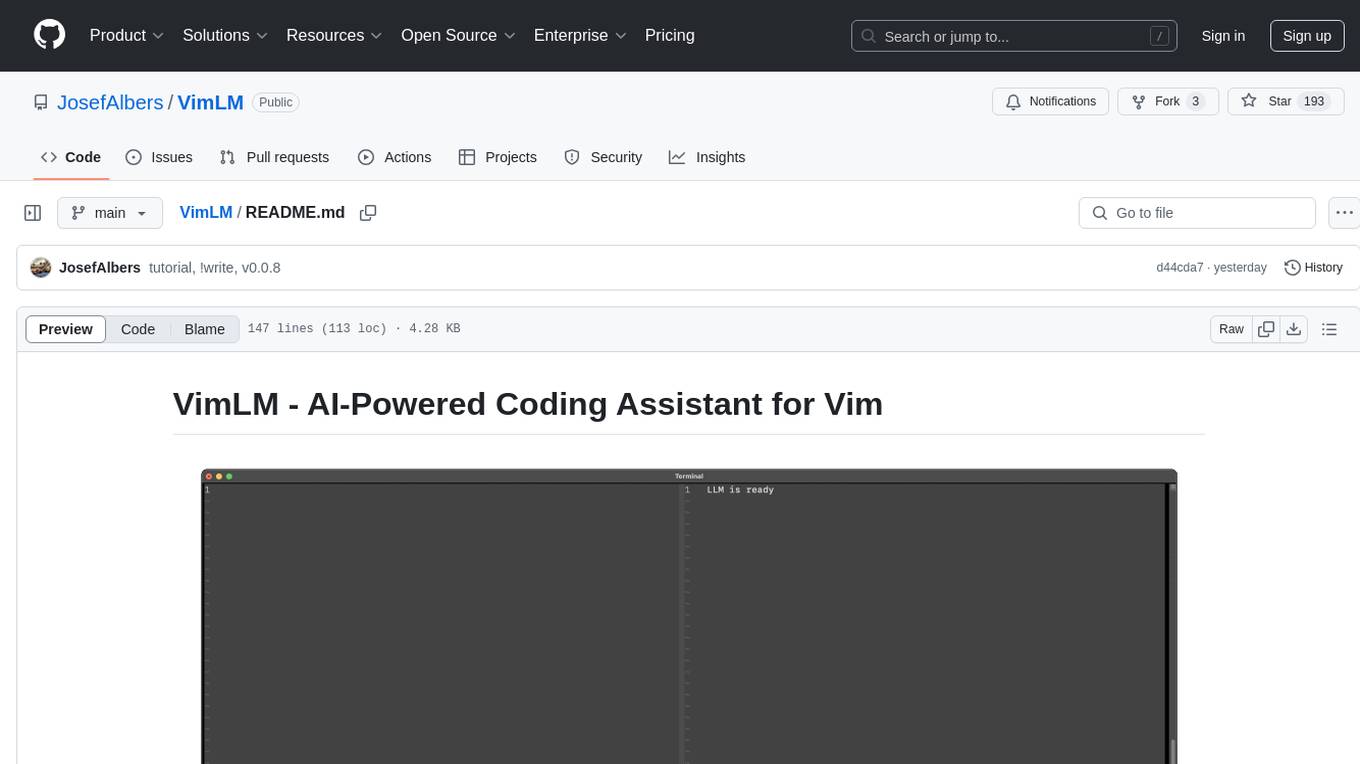
VimLM
VimLM is an AI-powered coding assistant for Vim that integrates AI for code generation, refactoring, and documentation directly into your Vim workflow. It offers native Vim integration with split-window responses and intuitive keybindings, offline first execution with MLX-compatible models, contextual awareness with seamless integration with codebase and external resources, conversational workflow for iterating on responses, project scaffolding for generating and deploying code blocks, and extensibility for creating custom LLM workflows with command chains.
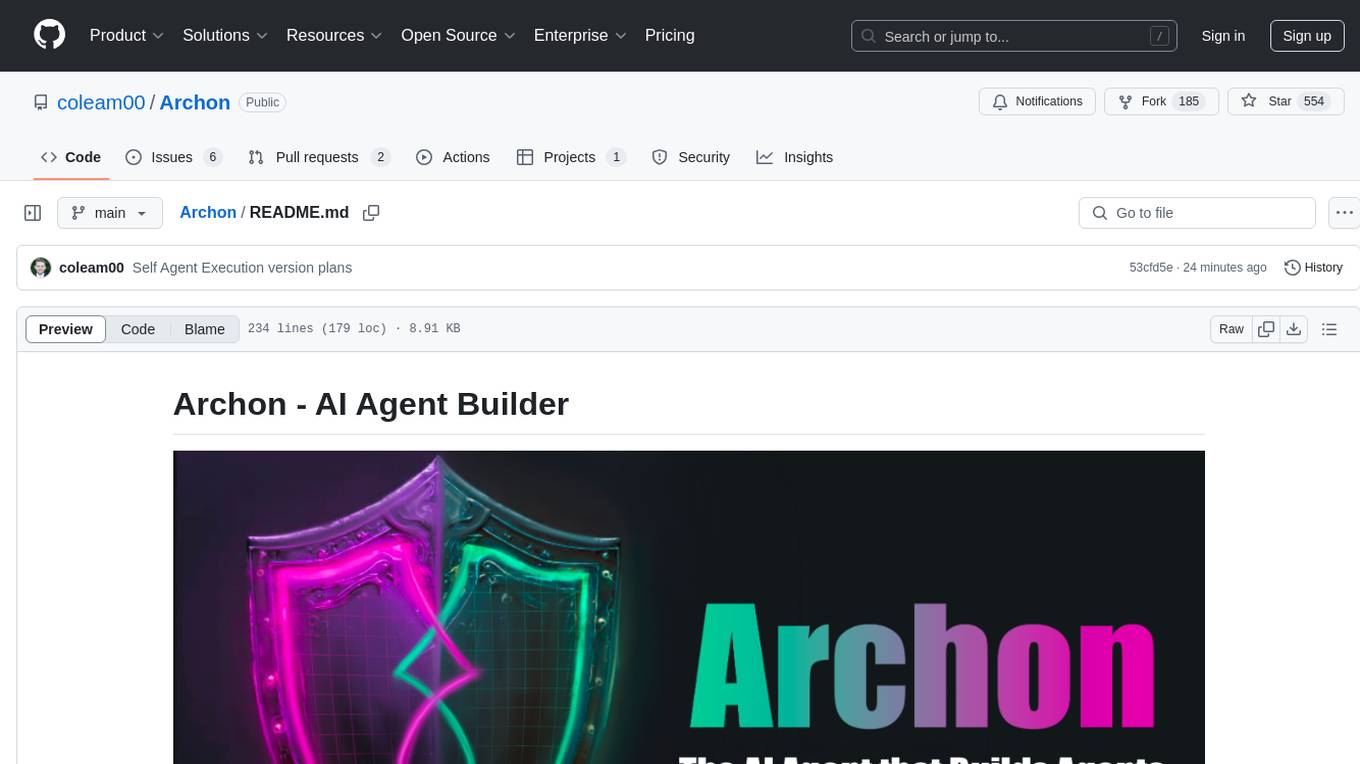
Archon
Archon is an AI meta-agent designed to autonomously build, refine, and optimize other AI agents. It serves as a practical tool for developers and an educational framework showcasing the evolution of agentic systems. Through iterative development, Archon demonstrates the power of planning, feedback loops, and domain-specific knowledge in creating robust AI agents.
For similar tasks
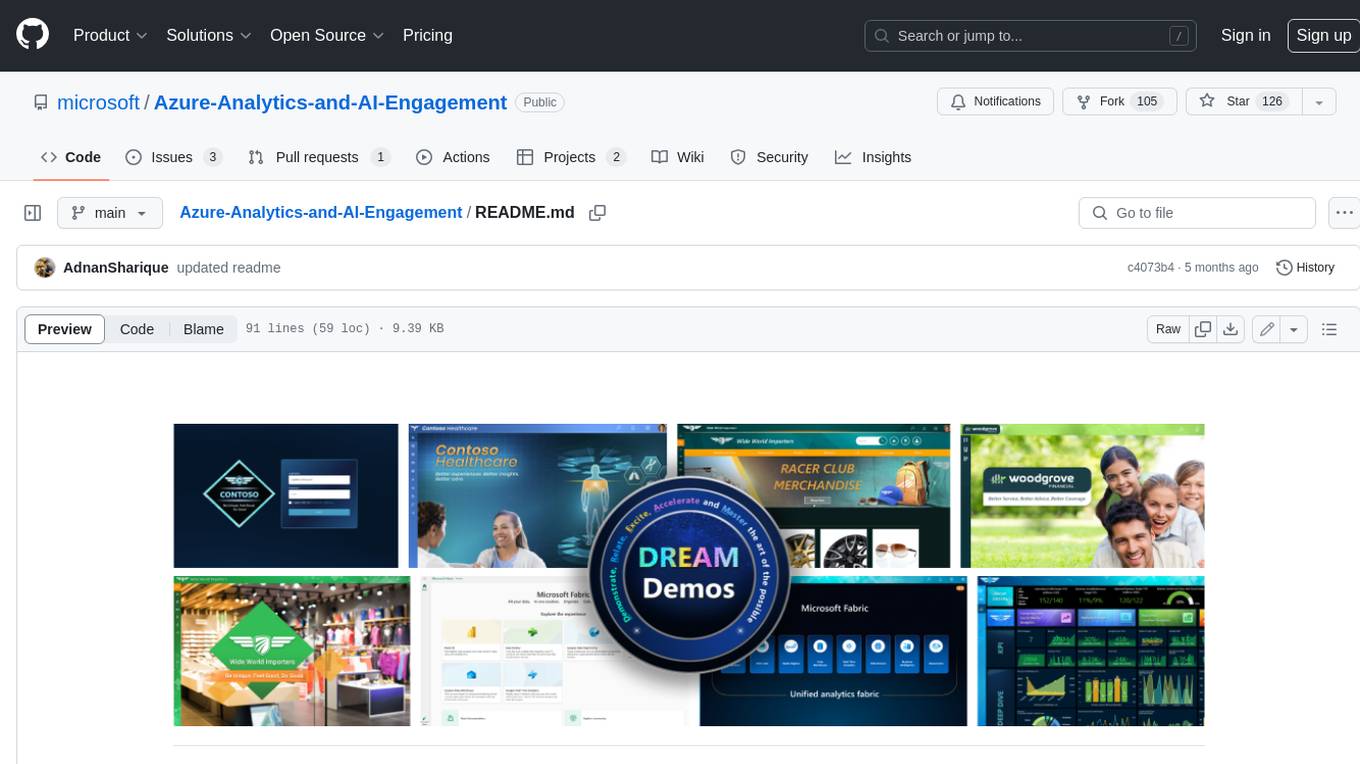
Azure-Analytics-and-AI-Engagement
The Azure-Analytics-and-AI-Engagement repository provides packaged Industry Scenario DREAM Demos with ARM templates (Containing a demo web application, Power BI reports, Synapse resources, AML Notebooks etc.) that can be deployed in a customer’s subscription using the CAPE tool within a matter of few hours. Partners can also deploy DREAM Demos in their own subscriptions using DPoC.
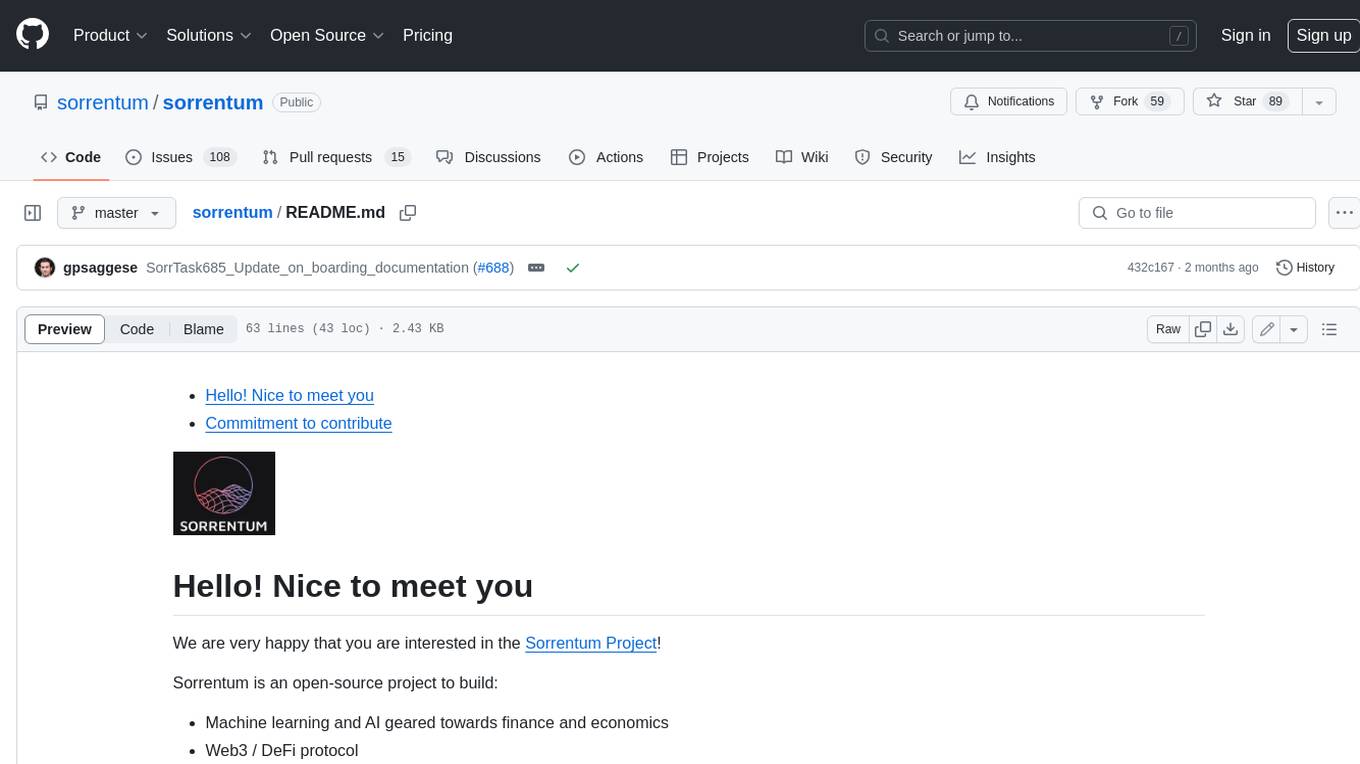
sorrentum
Sorrentum is an open-source project that aims to combine open-source development, startups, and brilliant students to build machine learning, AI, and Web3 / DeFi protocols geared towards finance and economics. The project provides opportunities for internships, research assistantships, and development grants, as well as the chance to work on cutting-edge problems, learn about startups, write academic papers, and get internships and full-time positions at companies working on Sorrentum applications.
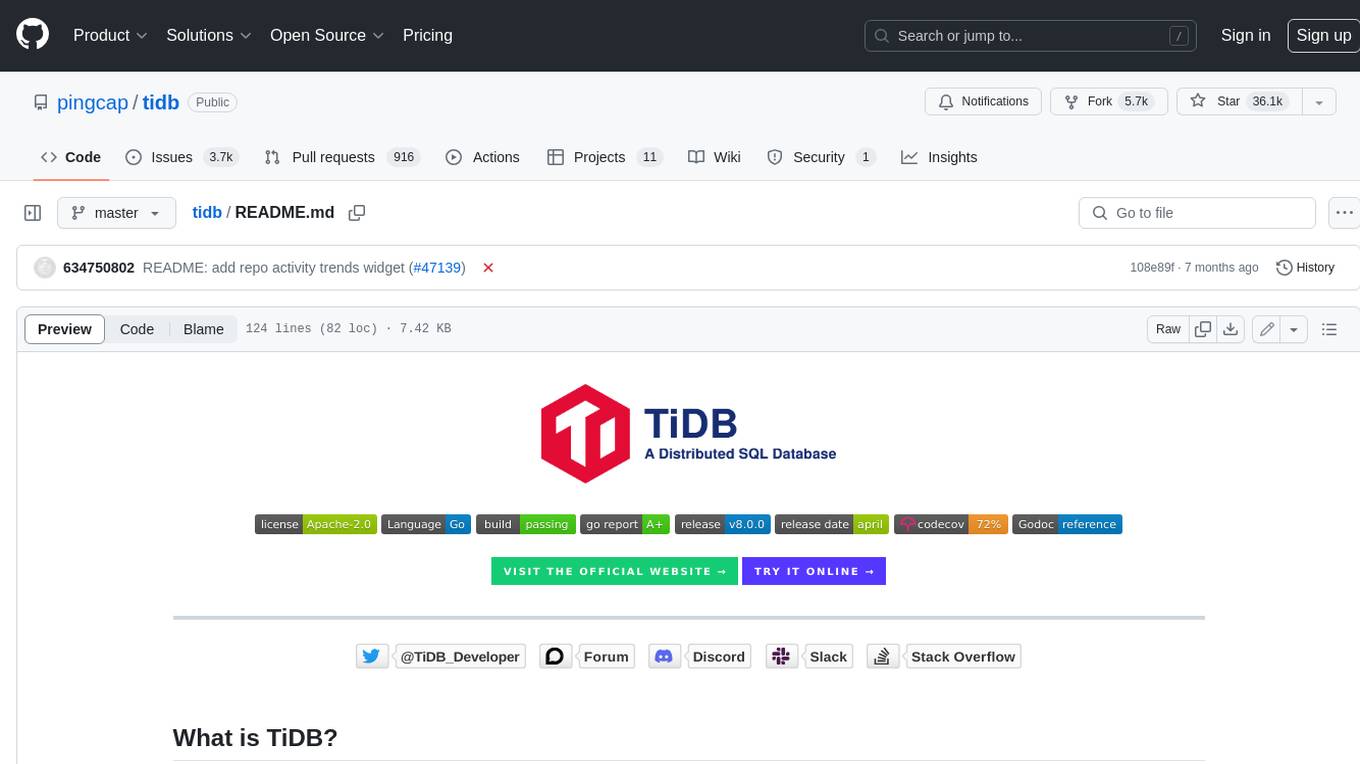
tidb
TiDB is an open-source distributed SQL database that supports Hybrid Transactional and Analytical Processing (HTAP) workloads. It is MySQL compatible and features horizontal scalability, strong consistency, and high availability.

zep-python
Zep is an open-source platform for building and deploying large language model (LLM) applications. It provides a suite of tools and services that make it easy to integrate LLMs into your applications, including chat history memory, embedding, vector search, and data enrichment. Zep is designed to be scalable, reliable, and easy to use, making it a great choice for developers who want to build LLM-powered applications quickly and easily.
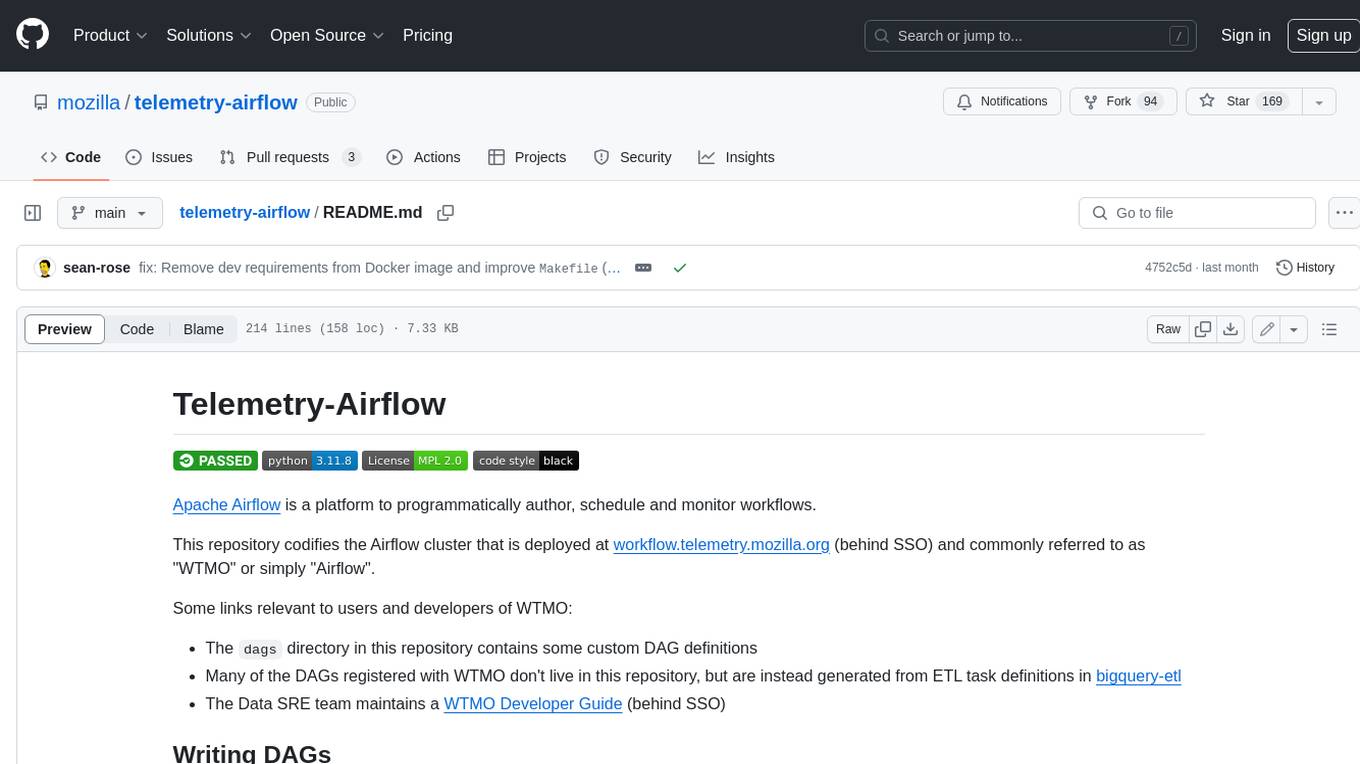
telemetry-airflow
This repository codifies the Airflow cluster that is deployed at workflow.telemetry.mozilla.org (behind SSO) and commonly referred to as "WTMO" or simply "Airflow". Some links relevant to users and developers of WTMO: * The `dags` directory in this repository contains some custom DAG definitions * Many of the DAGs registered with WTMO don't live in this repository, but are instead generated from ETL task definitions in bigquery-etl * The Data SRE team maintains a WTMO Developer Guide (behind SSO)
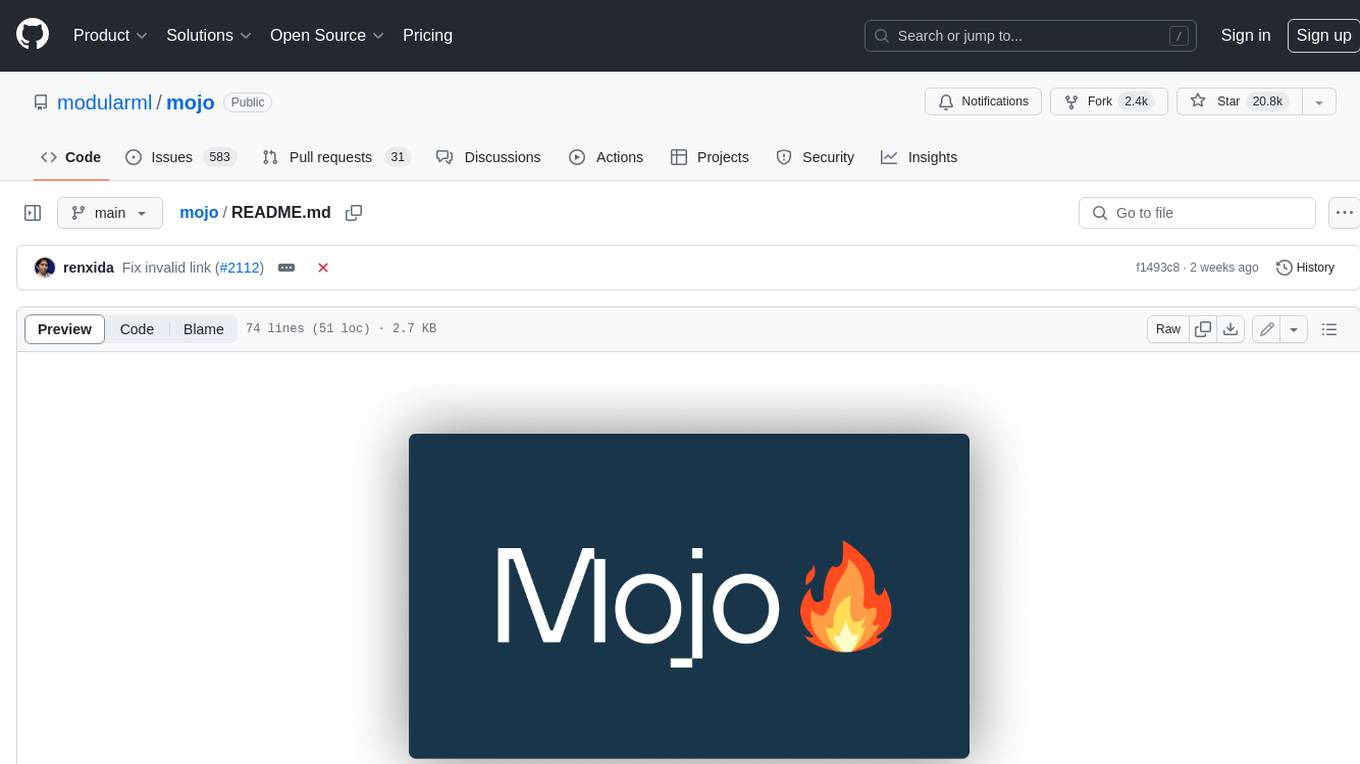
mojo
Mojo is a new programming language that bridges the gap between research and production by combining Python syntax and ecosystem with systems programming and metaprogramming features. Mojo is still young, but it is designed to become a superset of Python over time.
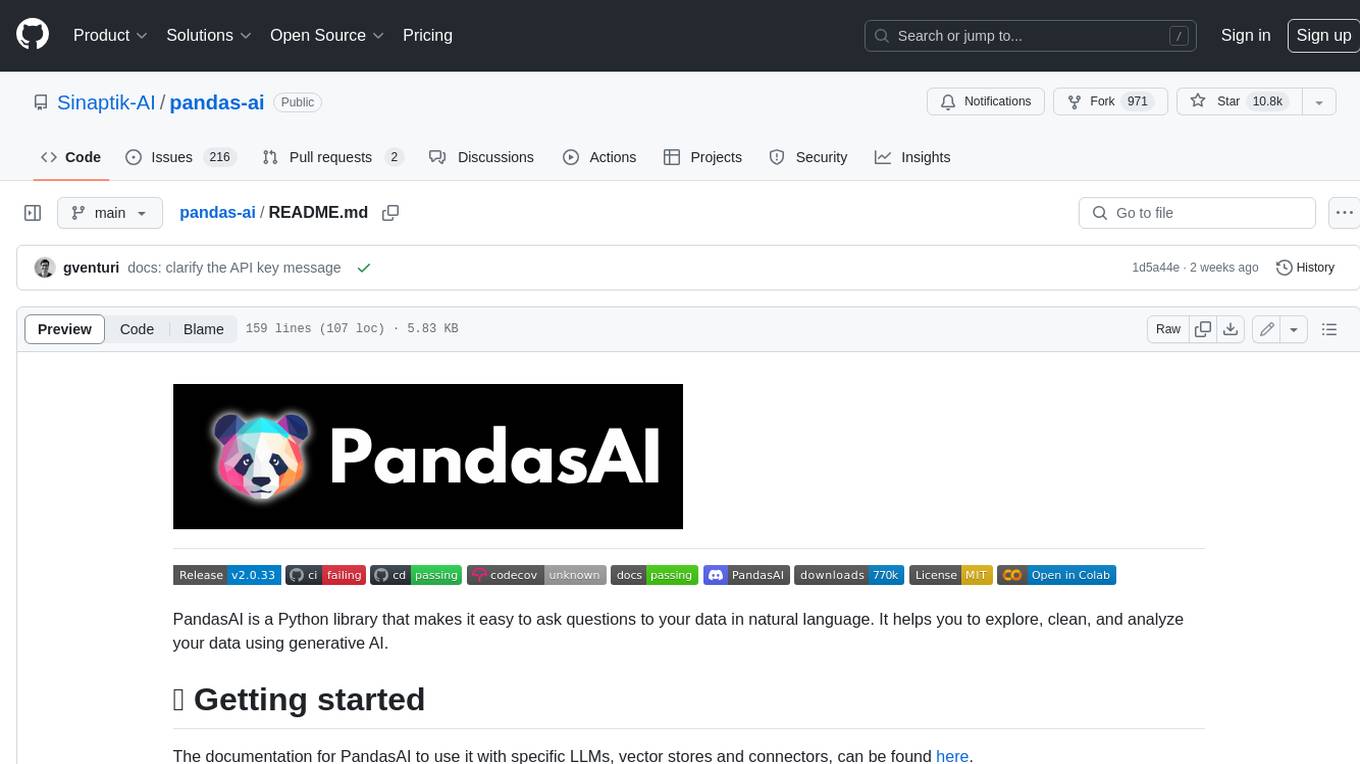
pandas-ai
PandasAI is a Python library that makes it easy to ask questions to your data in natural language. It helps you to explore, clean, and analyze your data using generative AI.
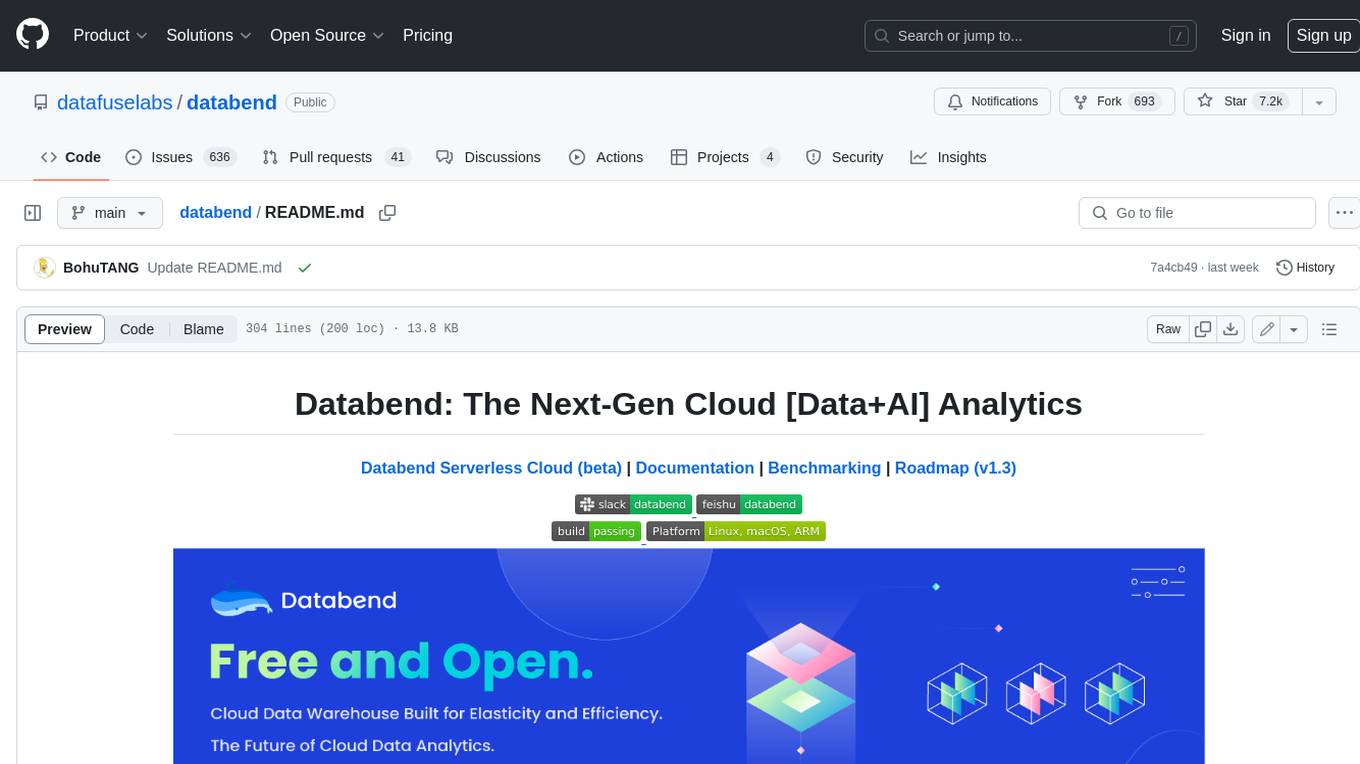
databend
Databend is an open-source cloud data warehouse that serves as a cost-effective alternative to Snowflake. With its focus on fast query execution and data ingestion, it's designed for complex analysis of the world's largest datasets.
For similar jobs

sweep
Sweep is an AI junior developer that turns bugs and feature requests into code changes. It automatically handles developer experience improvements like adding type hints and improving test coverage.

teams-ai
The Teams AI Library is a software development kit (SDK) that helps developers create bots that can interact with Teams and Microsoft 365 applications. It is built on top of the Bot Framework SDK and simplifies the process of developing bots that interact with Teams' artificial intelligence capabilities. The SDK is available for JavaScript/TypeScript, .NET, and Python.

ai-guide
This guide is dedicated to Large Language Models (LLMs) that you can run on your home computer. It assumes your PC is a lower-end, non-gaming setup.

classifai
Supercharge WordPress Content Workflows and Engagement with Artificial Intelligence. Tap into leading cloud-based services like OpenAI, Microsoft Azure AI, Google Gemini and IBM Watson to augment your WordPress-powered websites. Publish content faster while improving SEO performance and increasing audience engagement. ClassifAI integrates Artificial Intelligence and Machine Learning technologies to lighten your workload and eliminate tedious tasks, giving you more time to create original content that matters.

chatbot-ui
Chatbot UI is an open-source AI chat app that allows users to create and deploy their own AI chatbots. It is easy to use and can be customized to fit any need. Chatbot UI is perfect for businesses, developers, and anyone who wants to create a chatbot.

BricksLLM
BricksLLM is a cloud native AI gateway written in Go. Currently, it provides native support for OpenAI, Anthropic, Azure OpenAI and vLLM. BricksLLM aims to provide enterprise level infrastructure that can power any LLM production use cases. Here are some use cases for BricksLLM: * Set LLM usage limits for users on different pricing tiers * Track LLM usage on a per user and per organization basis * Block or redact requests containing PIIs * Improve LLM reliability with failovers, retries and caching * Distribute API keys with rate limits and cost limits for internal development/production use cases * Distribute API keys with rate limits and cost limits for students

uAgents
uAgents is a Python library developed by Fetch.ai that allows for the creation of autonomous AI agents. These agents can perform various tasks on a schedule or take action on various events. uAgents are easy to create and manage, and they are connected to a fast-growing network of other uAgents. They are also secure, with cryptographically secured messages and wallets.

griptape
Griptape is a modular Python framework for building AI-powered applications that securely connect to your enterprise data and APIs. It offers developers the ability to maintain control and flexibility at every step. Griptape's core components include Structures (Agents, Pipelines, and Workflows), Tasks, Tools, Memory (Conversation Memory, Task Memory, and Meta Memory), Drivers (Prompt and Embedding Drivers, Vector Store Drivers, Image Generation Drivers, Image Query Drivers, SQL Drivers, Web Scraper Drivers, and Conversation Memory Drivers), Engines (Query Engines, Extraction Engines, Summary Engines, Image Generation Engines, and Image Query Engines), and additional components (Rulesets, Loaders, Artifacts, Chunkers, and Tokenizers). Griptape enables developers to create AI-powered applications with ease and efficiency.